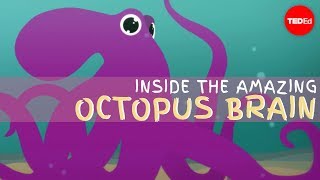What could octopuses possibly have in common with us?
章鱼和我们可能有什么共同点?
After all, they don't have lungs, spines, or even a plural noun we can all agree on.
毕竟它们没有肺和脊椎,甚至没有公认的名字。
But what they do have is the ability to solve puzzles,
但它们有解决问题的能力,
learn through observation, and even use tools, just like some other animals we know.
通过观察来学习的能力,甚至使用工具的能力,就像我们知道的一些其它动物。
And what makes octopus intelligence so amazing is that
而章鱼的智力十分令人惊奇,
it comes from a biological structure completely different from ours.
因为它的生物结构与我们的完全不同。
The 200 or so species of octopuses are mollusks belonging to the order cephalopoda, Greek for head-feet.
大约有200种章鱼属于头足目软体动物,这个词是头足的希腊语。
Those heads contain impressively large brains, with a brain to body ratio similar to that of other intelligent animals,
这些头里面有大得令人惊奇的大脑,大脑和身体比例和其它智慧动物类似,
and a complex nervous system with about as many neurons as that of a dog.
还有复杂的神经系统,神经元和狗的一样多。
But instead of being centralized in the brain,
但不同于中心化的大脑,
these 500 million neurons are spread out in a network of interconnected ganglia organized into three basic structures.
这5亿神经元分散在互联的神经节网络中,并组织成三种基本结构。
The central brain only contains about 10% of the neurons, while the two huge optic lobes contain about 30%.
中央大脑只包含约10%的神经元,而两个巨大的视神经叶包含约30%。
The other 60% are in the tentacles, which for humans would be like our arms having minds of their own.
另外60%在触手中,相当于人类有了能思维的手臂。
This is where things get even more interesting.
这一点十分有趣。
Vertebrates like us have a rigid skeleton to support our bodies, with joints that allow us to move.
像我们一样的脊椎动物有坚硬的骨骼支撑身体,而关节让我们能移动。
But not all types of movement are allowed.
但不是所有类型的移动都可以。
You can't bend your knee backwards, or bend your forearm in the middle, for example.
比如说,你不能把膝盖向后弯,或在前臂的中间弯折。
Cephalopods, on the other hand, have no bones at all, allowing them to bend their limbs at any point and in any direction.
头足动物与之相反,完全没有骨头,使他们能在任何一点向任意方向弯曲肢体,将触角自由弯折。
So shaping their tentacles into any one of the virtually limitless number of possible arrangements
在几乎无穷种可能的弯折方式中形成任何一种,
is unlike anything we are used to.
这不像我们习惯的任何事情。

Consider a simple task, like grabbing and eating an apple.
想象一个简单的任务,比如抓起一个苹果吃掉。
The human brain contains a neurological map of our body.
人的大脑包含我们身体的神经逻辑地图。
When you see the apple, your brain's motor center activates the appropriate muscles,
当你看见苹果,大脑的运动部分激活合适的肌肉,
allowing you to reach out with your arm, grab it with your hand, bend your elbow joint, and bring it to your mouth.
使你伸出手臂,用手抓住它,弯曲手肘,把它送到你嘴中。
For an octopus, the process is quite different.
对章鱼来说,过程却完全不同。
Rather than a body map, the cephalopod brain has a behavior library.
与身体地图不同,头足类的大脑有一个行为知识库。
So when an octopus sees food, its brain doesn't activate a specific body part, but rather a behavioral response to grab.
当章鱼看见食物,其大脑并不激活特定身体部位,而是产生一种行为反映:抓取。
As the signal travels through the network,
这个信号在神经网络里传递,
the arm neurons pick up the message and jump into action to command the movement.
触手神经元收到信息,转化为运动命令。
As soon as the arm touches the food, a muscle activation wave travels all the way through the arm to its base,
当触手一碰到食物,一个肌肉激活的信号从触手传递到基质,
while the arm sends back another wave from the base to the tip.
同时触手向触角也发送另一个信号。
The signals meet halfway between the food and the base of the arm, letting it know to bend at that spot.
信号在食物到基质的途中相遇,让神经元知道在这一点弯曲。
What all this means is that each of an octopus's eight arms can essentially think for itself.
这意味着,章鱼八只触角的每一只基本上都能自己思考。
This gives it amazing flexibility and creativity when facing a new situation or problem,
这赋予了当面临新问题时章鱼与众不同的灵活性和创造性,
whether its opening a bottle to reach food, escaping through a maze, moving around in a new environment,
无论打开瓶子来获得食物,从一个迷宫中逃出,移动到新的环境,
changing the texture and the color of its skin to blend into the scenery,
改变皮肤质感和颜色来融入环境,
or even mimicking other creatures to scare away enemies.
甚至模仿其它生物来吓退敌人。
Cephalopods may have evolved complex brains long before our vertebrate relatives.
头足纲动物也许已经发展出复杂的大脑,远远早于我们脊椎动物亲戚。
And octopus intelligence isn't just useful for octopuses.
章鱼的智力不仅仅对章鱼有用。
Their radically different nervous system and autonomously thinking appendages
它们完全不同的神经系统和自主思考的副肢
have inspired new research in developing flexible robots made of soft materials.
启发了新的研究,来开发由软材料制造的柔性机器人。
And studying how intelligence can arise along such a divergent evolutionary path
此外,研究智力在趋异的进化路程中如何产生,
can help us understand more about intelligence and consciousness in general.
能帮助我们更好地整体理解智力和意识。
Who knows what other forms of intelligent life are possible, or how they process the world around them.
谁知道其它形式的智慧生命可不可能呢,谁又知道它们如何操作身边的世界呢?











